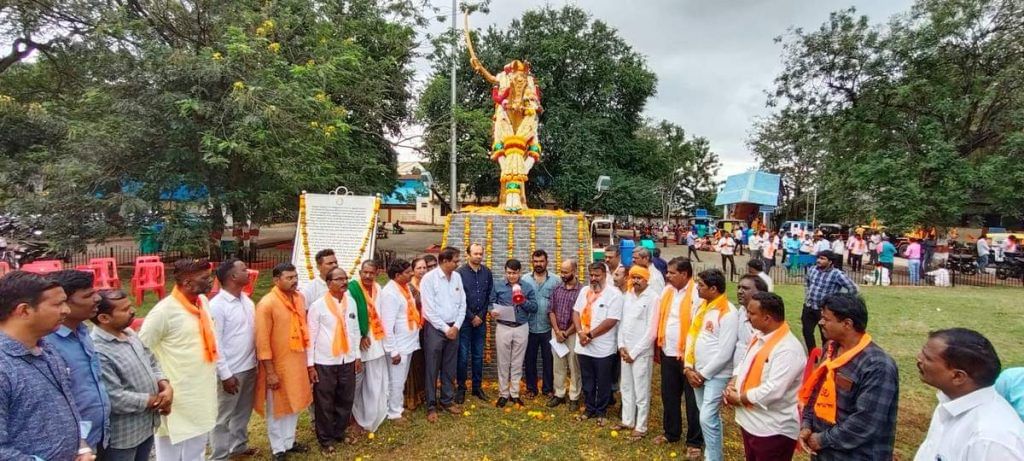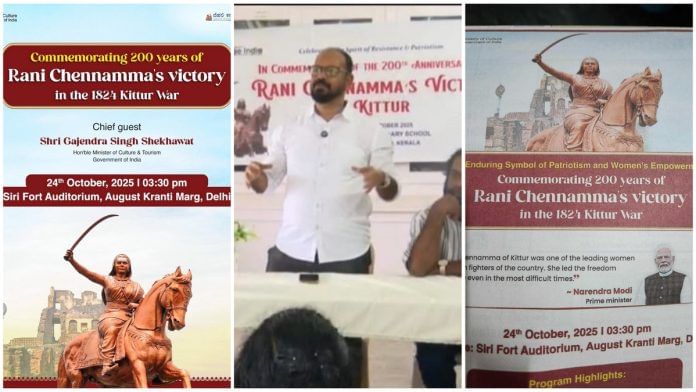New Delhi: Long before Rani Lakshmibai of Jhansi took up arms, another queen had already fought and won against the British in southern India. In 1824, Rani Chennamma of Kittur, in modern-day Karnataka, led one of India’s first rebellions against the East India Company—a legacy of resistance the Modi government is commemorating today.
She has long been an icon in Karnataka, but this week, the Ministry of Culture has gone all in on celebrating her. It has shared a flurry of posts on social media about her valour, organised a three-day festival for schoolchildren in Kerala, and today is holding an event marking 200 years of her Kittur victory at Delhi’s Siri Fort Auditorium, presided over by Culture Minister Gajendra Singh Shekhawat. A Rs 200 coin is also being issued in her honour. The ministry is calling her “the first warrior queen of India to lead a revolt against the British East India Company.”
Born in 1778 in Kakati, a small town in Belagavi district, Chennamma became queen of Kittur after marrying Raja Mallasarja Desai at the age of 15. When their only son died in 1824, she adopted Shivalingappa as heir.
But the East India Company refused to recognise him—a foreshadowing of its Doctrine of Lapse policy, which enabled the British to annex any princely state without a male heir. The rule, formally introduced under Lord Dalhousie in 1848, was made under the rationale that barring rulers from adopting successors would prevent “misrule.”
Rani Chennamma put her foot down, leading to one of India’s earliest rebellions against British colonial rule. She refused to exile her adopted son, and when her letter to Lord Elphinstone pleading her case failed, war broke out. At first she was victorious, until “the evil designs of the British” prevailed, wrote Nanditha Krishna, a Chennai-based historian.
Two centuries later, Rani Chennamma has become an enduring symbol of patriotism and women’s empowerment.
“Rani Chennamma of Kittur was one of the leading women freedom fighters of the country. She led the freedom struggle in the most difficult times,” said Prime Minister Narendra Modi in newspaper ad ahead of the Delhi commemoration.
Also Read: From Lahore jail to Bose’s INA—women who fought for India’s freedom but remained forgotten
What happened in the Battle of Kittur
Kittur was a small state often caught in conflicts with Tipu Sultan of Mysore and the Peshwas of Maharashtra and this instability is said to have facilitated British meddling. When Rani Chennamma’s husband, Mallasarja, died in 1816, their eldest son, Shivalinga Rudra Sarja, ascended the throne but he was in poor health and his mother held the reins. So it continued until he died and it was time to appoint a successor—Chennamma’s adopted son Shivalingappa.
The British ordered them both into exile, invoking their claim of paramountcy and complete authority. When she refused to comply, the British used force.
“With a force of 20,000 men and 400 guns, mainly from the third troop of Madras Native Horse Artillery, they attacked Kitturu,” wrote Krishnan. “The British tried to confiscate the treasures and jewels of Kitturu, valued at around Rs. 1.5 million, but in vain.”

Chennamma was ready for them and inflicted damage quickly.
In October 1824, as the first battle began, British political agent and collector St John Thackeray was killed in a fierce attack led by Chennamma’s lieutenant, Amatur Balappa. Two officers, Sir Walter Elliot and Mr Stevenson, were taken hostage and released only after promising to end the war.
But, as Krishnan put it, the British “cheated” her and returned with more troops to re-ignite the war. Chennamma and her lieutenants Sangolli Rayanna and Gurusiddappa managed to fell the sub-collector of Solapur but they were outnumbered and the walls of Kittur could only stand for so long. And, she was captured.
She was imprisoned in Bailhongal Fort, never to return to Kittur. After her death in 1829, Shivalingappa and her loyal general Rayanna continued the fight but both were captured— Shivalingappa was jailed, and Rayanna was hanged.
Also Read: Rani Rashmoni to Helen Lepcha—women revolutionaries were fighting Indian society & the British
The woman who didn’t settle
Chennamma’s story didn’t end with her death. Folk singers still carry her name in ballads and there’s even a song sung in schools about the “brave queen of Kittur”. Her most familiar image shows her fierce and unyielding in a green sari, sword in hand, astride a horse.
In 1961, Kannada cinema brought her story to the screen in Kitturu Chennamma, with B Saroja Devi playing the queen. India honoured her with a postage stamp in 1977, and a Coast Guard ship once carried her name. The Rani Chennamma Express links Bengaluru and Sangli, and in Belagavi, Rani Chennamma University stands as a lasting tribute. In 2007, then president Pratibha Patil unveiled her statue in the Parliament complex.
Every October, Karnataka honours Rani Chennamma through Kittur Utsava, held from 22 to 24 October. At an event in Kalaburagi Thursday, MLC Shashil G Namoshi said Chennamma mastered horse riding and swordsmanship at a young age and called for a statue of her to be installed at a major city junction.
“A salute to the valor of Rani Chennamma of Kittur! 🇮🇳✨
In 1824, she stood tall against British rule, igniting the first spark of India’s freedom struggle with unmatched courage and pride.#RaniChennamma #KitturQueen #IndiaPost #DakSevaJanSeva #WomenOfCourage pic.twitter.com/rTpgZuNacm
— Karnataka Postal Circle (@CPMGKARNATAKA) October 23, 2025
“Her contribution deserves to be remembered as a symbol of women’s empowerment and resistance,” said writer Neelambika Police Patil in her special lecture.
Rani Chennamma’s samadhi lies in Bailhongal, in a quiet park maintained by the state government. In May, Chief Minister Siddaramaiah urged the Modi government to declare it a national monument to “instil pride in our collective heritage.”
(Edited by Asavari Singh)






